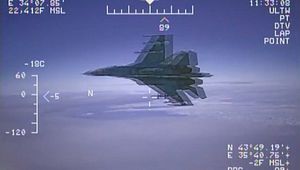On January 29th, a Russian fighter jet aggressively intercepted a U.S. Navy surveillance plane over the Black Sea. The intercept appears to be the most dangerous of its type between Russia and the United States in recent years, but is only the latest in a string of increasingly aggressive Cold War-style antics conducted by Russian forces against U.S. ships and aircraft operating in international waters or airspace.
The United States Sixth Fleet statement said the intercept lasted nearly three hours, culminating in the Russian Su-27 buzzing the U.S. EP-3 at a distance of only five feet, as shown in video released by the U.S. Navy. The Russian jet then crossed ahead of the U.S. plane’s flight path, forcing it to fly through the Russian’s jetwash. Jetwash is the aeronautical equivalent of to the turbulent wake that trails behind a large ship; flying through it is extremely dangerous and has caused airplanes to crash.
According to the U.S. Navy, the EP-3 is an advanced signals intelligence aircraft that collect electronic emissions to provide real-time tactical intelligence. The planes’ sensitive equipment allow them to soak up information while remaining in international airspace, which has often made them targets of harassment from countries being collected-on, particularly by China.
This latest Russian intercept is reminiscent of the famous 2001 intercept of another U.S. EP-3 aircraft by a Chinese fighter jet over the South China Sea. Over a period of months Chinese pilots had been intercepting U.S. surveillance flights with increasing aggression and at shorter and shorter ranges. Then in April, a Chinese pilot accidentally clipped the U.S. plane while buzzing it. The Chinese jet crashed, killing the pilot, and the EP-3 was forced to make an emergency landing at a Chinese air force base on Hainan island.
The U.S. Sixth Fleet’s statement acknowledged that the Russian jet has the right to operate in the same international airspace as the United States, but suggested that its intercept violated the terms of a Cold War-era agreement between the United States and Russia intended specifically to prevent dangerous behavior, and that the incident risked miscalculation and a mid-air collision.
In 1972, motivated in part by a mutual concern that such incident between ships or aircraft could lead to a catastrophic, unintended military escalation, the United States and Soviet Union concluded an agreement to prevent incidents on and over the high seas, known as INCSEA. The agreement established binding rules for the conduct of each countries’ ships and aircraft around the other and provided a mechanism for the two militaries to meet annually to discuss incidents and improve the safety of conduct between them. INCSEA remains in force with Russia today and delegations from the two militaries met most recently last July in Newport, Rhode Island for the annual review the agreement stipulates.
Russia’s increasing aggression and operational intensity toward U.S. ships and aircraft over the past several years suggests that it perceives much lower escalation risks and less serious potential consequences from an aerial or maritime incident with the United States today than when INCSEA was agreed to. The dynamic between changing threat perception and Russia’s willingness to ignore agreements designed to prevent unsafe conduct by its military should inform similar efforts to bind China’s conduct in the South China Sea and Western Pacific.
The United States and Chinese militaries signed an INCSEA-like agreement in 2015. The United States hopes it will dampen aggressive Chinese intercepts like the one that led to the 2001 EP-3 tragedy. However, the lag in signing the agreement following that incident and the regular intercept of U.S. planes near the Chinese coast since then, signals that China perceives too much value from this aerial behavior, and too little risk from it, to curtail dangerous conduct against U.S. planes.
Similar hopes of mitigating aggressive Chinese tactics has motivated a nearly three-decade pursuit of a binding code of conduct between China and ASEAN states in the South China Sea. The two parties have vowed to make real progress (again) on the Code this year, but even if a strong code is agreed to, the record of those similar agreements between Russia and the United States and the United States and China suggest China will have little compunction violating its terms when it deems fit.

































